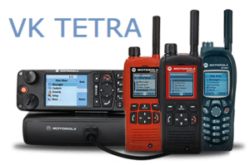Amateur Tetra radio is here, and has active participation in many counties around the world including Australia!
If you’re looking at how to get started with Amateur Tetra Radio, read on.
What is Tetra Radio?
Terrestrial Trunked Radio (TETRA; formerly known as Trans-European Trunked Radio), a European standard for a trunked radio system, is a professional mobile radio and two-way transceiver specification. TETRA was specifically designed for use by government agencies, emergency services, (police forces, fire departments, ambulance) for public safety networks, rail transport staff for train radios, transport services and the military. TETRA is the European version of trunked radio, similar to Project 25.
TETRA is a European Telecommunications Standards Institute (ETSI) standard, first version published 1995; it is mentioned by the European Radiocommunications Committee (ERC)
(source: wikipedia)
What is the difference between Tetra and P25?
Project 25 and TETRA are utilised for the public safety Radio network and Private Sector Radio network worldwide however, it has some differences in technical features and capacities.
- TETRA: It is optimized for high population density areas, with spectral efficiency (4 time slots in 25 kHz: four communications channels per 25 kHz channel, an efficient use of spectrum). It is suitable for high population density areas and Supports full duplex voice, data and messaging. but, it is generally unavailable for simulcast, VHF band – however particular vendors have introduced Simulcast and VHF into their TETRA platform..
- P25: it is optimized for wider area coverage with low population density, and support for simulcast. however, it is limited to data support. (Phase 1 P25 radio systems operate in a 12.5 kHz analogue, digital or mixed mode, and P25 Phase II will use a 2-timeslot TDMA structure in 12.5 kHz channels.
Currently, P25 deployed to more than 53 countries and TETRA deployed to more than 114 countries.
(source: wikipedia)
How do I get started using Tetra as an amateur?
First, you’ll need a Tetra radio that’s capable of transmitting and receiving within the licensed ham bands within your country. This is typically around 430-440mhz.
I’ve put together a Detailed Radio Buying Guide which covers what radios to consider, how they work, and some common tips and tricks to ensure you get the right radio.
Next, check to see if you live in the footprint of an existing Tetra gateway. Tetra gateways work very similarly to DMR or P25 gateways and provide coverage for all amateurs to talk on the Tetra network.
Check out the Tetra Dashboard map to see where all current gateways are. You can also check out the VK specific gateways right here on VKTetra.com from the menu at the top.
If you’re in the footprint of an existing gateway, simply program your radio and start talking on the network!
If you’re not in the coverage footprint of an existing gateway, why not Build Your Own! Not only will you give yourself access to the Tetra network, you’ll also be expanding the network for all to use.
Is there a dashboard?
Yes! There’s a dashboard showing the current status of Tetra talkgroups and gateways, as well as a dashboard showing the current P25 10444 reflector status
Tetra: Tetra Dashboard
What if I don’t have a TETRA radio?
If you don’t have a TETRA radio, you can connect to the VK Tetra network via Echolink. Simply connect to VK2CJC-L – Node 475538.
I’d like an account to access your reflector
To request an account for your gateway, please contact me
